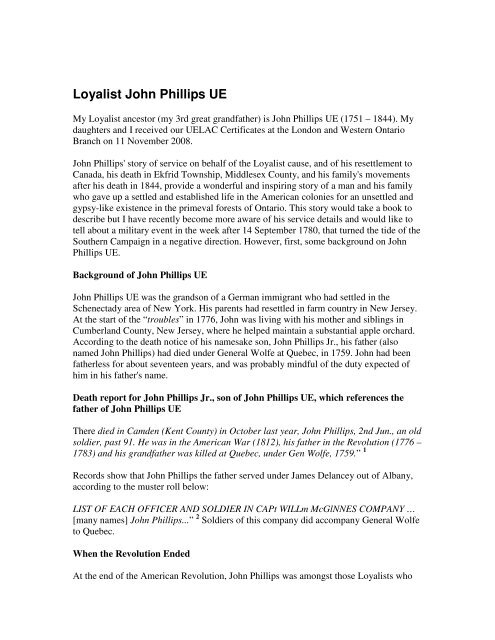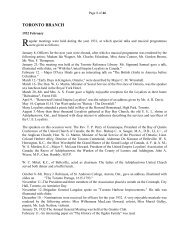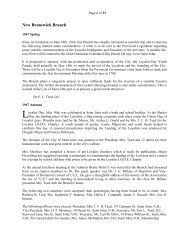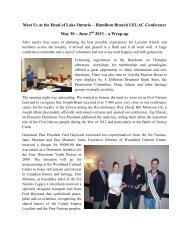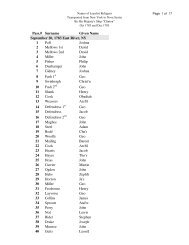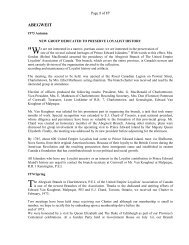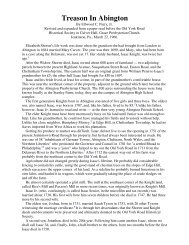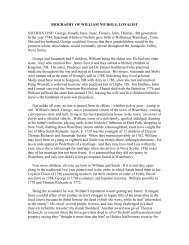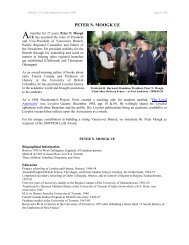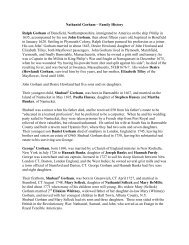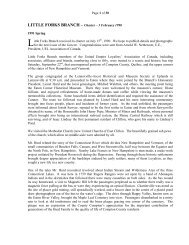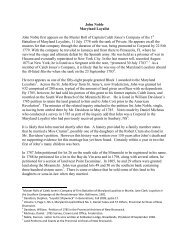Loyalist John Phillips UE - for United Empire Loyalists
Loyalist John Phillips UE - for United Empire Loyalists
Loyalist John Phillips UE - for United Empire Loyalists
You also want an ePaper? Increase the reach of your titles
YUMPU automatically turns print PDFs into web optimized ePapers that Google loves.
<strong>Loyalist</strong> <strong>John</strong> <strong>Phillips</strong> <strong>UE</strong><br />
My <strong>Loyalist</strong> ancestor (my 3rd great grandfather) is <strong>John</strong> <strong>Phillips</strong> <strong>UE</strong> (1751 – 1844). My<br />
daughters and I received our <strong>UE</strong>LAC Certificates at the London and Western Ontario<br />
Branch on 11 November 2008.<br />
<strong>John</strong> <strong>Phillips</strong>' story of service on behalf of the <strong>Loyalist</strong> cause, and of his resettlement to<br />
Canada, his death in Ekfrid Township, Middlesex County, and his family's movements<br />
after his death in 1844, provide a wonderful and inspiring story of a man and his family<br />
who gave up a settled and established life in the American colonies <strong>for</strong> an unsettled and<br />
gypsy-like existence in the primeval <strong>for</strong>ests of Ontario. This story would take a book to<br />
describe but I have recently become more aware of his service details and would like to<br />
tell about a military event in the week after 14 September 1780, that turned the tide of the<br />
Southern Campaign in a negative direction. However, first, some background on <strong>John</strong><br />
<strong>Phillips</strong> <strong>UE</strong>.<br />
Background of <strong>John</strong> <strong>Phillips</strong> <strong>UE</strong><br />
<strong>John</strong> <strong>Phillips</strong> <strong>UE</strong> was the grandson of a German immigrant who had settled in the<br />
Schenectady area of New York. His parents had resettled in farm country in New Jersey.<br />
At the start of the “troubles” in 1776, <strong>John</strong> was living with his mother and siblings in<br />
Cumberland County, New Jersey, where he helped maintain a substantial apple orchard.<br />
According to the death notice of his namesake son, <strong>John</strong> <strong>Phillips</strong> Jr., his father (also<br />
named <strong>John</strong> <strong>Phillips</strong>) had died under General Wolfe at Quebec, in 1759. <strong>John</strong> had been<br />
fatherless <strong>for</strong> about seventeen years, and was probably mindful of the duty expected of<br />
him in his father's name.<br />
Death report <strong>for</strong> <strong>John</strong> <strong>Phillips</strong> Jr., son of <strong>John</strong> <strong>Phillips</strong> <strong>UE</strong>, which references the<br />
father of <strong>John</strong> <strong>Phillips</strong> <strong>UE</strong><br />
There died in Camden (Kent County) in October last year, <strong>John</strong> <strong>Phillips</strong>, 2nd Jun., an old<br />
soldier, past 91. He was in the American War (1812), his father in the Revolution (1776 –<br />
1783) and his grandfather was killed at Quebec, under Gen Wolfe, 1759.” 1<br />
Records show that <strong>John</strong> <strong>Phillips</strong> the father served under James Delancey out of Albany,<br />
according to the muster roll below:<br />
LIST OF EACH OFFICER AND SOLDIER IN CAPt WILLm McGlNNES COMPANY …<br />
[many names] <strong>John</strong> <strong>Phillips</strong>...” 2 Soldiers of this company did accompany General Wolfe<br />
to Quebec.<br />
When the Revolution Ended<br />
At the end of the American Revolution, <strong>John</strong> <strong>Phillips</strong> was amongst those <strong>Loyalist</strong>s who
was first resettled to Parrtown, Nova Scotia, (later New Brunswick). His name is found<br />
on the “Post War Settlement; 2nd Battalion New Jersey Volunteers [List of names of<br />
officers and men of the 2nd Battalion, New Jersey Volunteers, who received grants of<br />
land in King’s County, New Brunswick. Dated 14 July 1784.] 3<br />
<strong>John</strong> filed a petition <strong>for</strong> land at Woodhouse, Norfolk County, Ontario, in 1801, as<br />
follows:<br />
“12 Feb 1801: <strong>John</strong> <strong>Phillips</strong>, Woodhouse – was in his Majesty's service during the whole<br />
of the Revolution in America in the capacity of a Corporal in the 2nd Battalion, New<br />
Jersey Volunteers commanded by Colonel Isaac Allen; discharged at St. <strong>John</strong>, New<br />
Brunswick; now in the Province with an extensive family of a wife & 7 children &<br />
without any land to support them; requested a grant; OC – Recommended <strong>for</strong> 200 acres.”<br />
4<br />
Although <strong>John</strong> states that he served under Lt. Col. Isaac Allen, the commanding officer<br />
<strong>for</strong> all of the NJV, his immediate field commander was Robert Drummond. Robert<br />
Drummond had returned to England by this date, after humiliating capture and defeat,<br />
and was not likely a good person <strong>for</strong> <strong>John</strong> <strong>Phillips</strong> to reference in his land petition. Lt.<br />
Col. Isaac Allen, though, is referenced <strong>for</strong> support many times in <strong>Loyalist</strong> petitions in<br />
<strong>Loyalist</strong>s in the American Revolution, 5 and his name would have drawn, and did draw,<br />
immediate recognition from the land councils.<br />
<strong>John</strong> <strong>Phillips</strong> <strong>UE</strong> in the American Revolution<br />
<strong>Phillips</strong>, at age 25 or 26 6 , had first enrolled in the West Jersey Volunteers. This unit was<br />
raised earlier in 1777 while the British Army was in Philadelphia. These men came from<br />
Salem, Gloucester and Cumberland Counties. <strong>John</strong> <strong>Phillips</strong> was first transferred to the<br />
First Battalion, New Jersey Volunteers, under Lt. Col. Joseph Barton. After August 1778,<br />
he was promoted to Corporal, and moved to the Second Battalion, New Jersey<br />
Volunteers, commanded by Robert Drummond.<br />
“Drummond was a wealthy merchant and ship-owner at Acquakanonk Landing, New<br />
Jersey. When trouble between this country and England first became apparent, his<br />
thoughts and counsel were with the American cause; he was a member of the Provincial<br />
Congress and its speaker <strong>for</strong> two terms, but when war broke out he tendered his services<br />
to his king and organized the Second Battalion of New Jersey Volunteers and was<br />
commissioned its major. He enlisted about two hundred men, principally from the Bergen<br />
county side of the river. He saw service in the South, where most of his men fell victims to<br />
disease consequent upon the climate. He was later promoted to Major. After the war,<br />
Drummond removed to England, where he died in 1789.” 7<br />
The New Jersey Volunteers received their uni<strong>for</strong>ms in April of 1776. The uni<strong>for</strong>ms were<br />
green and white. Thereafter, their enemies often referred to them as “The Greens”. 8<br />
For more detailed in<strong>for</strong>mation on the New Jersey Volunteers, see the online history from<br />
the <strong>Loyalist</strong> Institute, at http://www.royalprovincial.com/military/rhist/njv/3njvhist.htm.
In August 1778, <strong>John</strong> <strong>Phillips</strong> was in a military hospital <strong>for</strong> unknown reasons, on Staten<br />
Island 9 . <strong>John</strong> was possibly treated by a doctor named 'Archibald Campbell', which may<br />
account <strong>for</strong> the fact that <strong>John</strong> named his first son 'Archibald'.<br />
By November 1779, the company was in good order at Savannah:<br />
Muster Roll, Captain Robert Drummond's Company, Third Battalion, New Jersey<br />
Volunteers, Savannah GA, 29 November 1779 ... [many names and ranks] Corporal <strong>John</strong><br />
<strong>Phillips</strong>.” 10<br />
"On 14 September 1780, Col. Robert Drummond's Battalion of the New Jersey<br />
Volunteers were camped at Fort Grierson, near Camp Augusta in Georgia. They did not<br />
suspect that a combined rebel <strong>for</strong>ce was approaching on three fronts. The Rebel <strong>for</strong>ces<br />
were led Col. Elijah Clarke. Col. Clarke sent one element of his <strong>for</strong>ces under Major<br />
Samuel Taylor to attack the <strong>Loyalist</strong> Creek Indians at Indian Springs. He sent a second<br />
element under Col. James McCall to circle south of Augusta and attack towards St. Pauls<br />
Church and took the largest group with himself, to attack Fort Grierson. As the <strong>Loyalist</strong>s<br />
had superior <strong>for</strong>ces, he had to depend on strategy and surprise. It turned out that he was<br />
successful, and the Southern Campaign took significant losses and humiliation over the<br />
four days of battle which followed.<br />
St. Paul's (old Fort Augusta) and Fort Grierson (under Drummond and the New Jersey<br />
Volunteers) were incapacitated. At Grierson, one soldier was killed, one sergeant and five<br />
soldiers were wounded, and Robert Drummond and eighteen others were made prisoner.<br />
Col. Clarke released and armed over seventy Rebel soldiers who had been in jail, seized<br />
Indian “presents” valued at over £ 4,000, and “liberated” much of the arms and<br />
ammunition that had been turned over by surrendering <strong>Loyalist</strong> <strong>for</strong>ces. In the course of<br />
the ensuing firefight through the streets of Augusta, Captain Andrew <strong>John</strong>son, of the<br />
King's Carolina Rangers, was killed. " 11<br />
This week's events spelled the end of the Southern Campaign in Georgia and South<br />
Carolina. Major Robert Drummond failed to anticipate and defeat the enemy. Col. Elijah<br />
Clarke had proven himself the superior adversary.<br />
Hence we next see this service record:<br />
“Muster Roll, Major Robert Drummond's Company, Third Battalion, New Jersey<br />
Volunteers, 96, South Carolina, 60 days inclusive, 24 February 1781 to 24 April 1781, 61<br />
days inclusive:<br />
Major - Drummond, Robert (remarks) 'prisoner on parole at Charlestown' full roster<br />
follows, including Corporal <strong>John</strong> <strong>Phillips</strong> (not a prisoner)” 12<br />
By April 1782, the mention of Major Drummond being a prisoner is missing from the roll<br />
13
“Muster Roll, Major Robert Drummond's Company, Third Battalion, New Jersey<br />
Volunteers, Charlestown, South Carolina, 25 April 1782 to 24 June 1782, 61 days<br />
inclusive:<br />
1. Major Robert Drummond (no remark)<br />
2. Lieutenant <strong>John</strong> Jenkins (no remark)<br />
3. Ensign Lewis Thompson (remark: on command)<br />
4. 3 Sergeants, (no remark)<br />
Corporal <strong>John</strong> <strong>Phillips</strong> (remark: on command).”<br />
By the end of December 1782, it was all over. Charlestown with the NJV sailed back to<br />
the British garrison at New York. Finally, the N.J. Volunteers arrived in Parrtown (later<br />
St. <strong>John</strong>) New Brunswick in October of 1783 aboard armed ships of the British fleet.<br />
The next service record 14 states:<br />
“Muster Roll, Major Robert Drummond's Company, Third Battalion, New Jersey<br />
Volunteers, Dutch Kiln's, Long Island, New York, 25 December 1782 to 23 February<br />
1783, 61 days inclusive ...” the entire company there, including Corporal <strong>John</strong> <strong>Phillips</strong>.<br />
The Company has been evacuated to Long Island, New York.<br />
It is estimated that 14,000 <strong>Loyalist</strong>s from many regiments and companies, were resettled<br />
in New Brunswick after the war ended in 1783.<br />
Just be<strong>for</strong>e or after the muster role starting December 25 1782, <strong>John</strong> <strong>Phillips</strong> was married<br />
to Isabella Phinney.<br />
<strong>John</strong> Philips and Isabella Phinney married 178- -- --” [year, month, and date missing.] 15.<br />
Their first child, Archibald <strong>Phillips</strong>, was born 1783 in New Brunswick. 16<br />
The marriage record, noted in Schenectady, shows that this was the <strong>Phillips</strong> family<br />
cluster to which <strong>John</strong> was connected, even though his immediate family had been in New<br />
Jersey at the outbreak of the war.<br />
Isabella Phinney (1763 – 1849), wife of <strong>John</strong> <strong>Phillips</strong> <strong>UE</strong>, is probably the daughter of<br />
Peter Phinney <strong>UE</strong> (1737 – 1824). Peter Phinney <strong>UE</strong> appears on “The Old <strong>United</strong> <strong>Empire</strong><br />
<strong>Loyalist</strong> List” 17 , as follows: “Eastern District, Soldier Royal Regiment of New York,<br />
Muster Roll. P.L.N.J. 1786”, with his son George Phinney. However, Peter Phinney<br />
appears to have recanted and returned to the U.S.A. after 1786. <strong>John</strong> <strong>Phillips</strong> named his<br />
third son Peter, born in 1786, and his youngest son George, born in 1812, perhaps in<br />
honour of his Phinney in-laws.<br />
In June 1787, <strong>John</strong> Phillip's lands in New Jersey were confiscated:<br />
“A list of the names of all those Persons whose property was Confiscated in the Several<br />
Counties of the State of New Jersey, <strong>for</strong> joining the Army of the King of Great Britain &c.<br />
as returned to the Auditors Office, previous to the first day of May 1787 ... Cumberland
County NJ .... <strong>John</strong> PHILIPS... others... Extract from the publick books in my office given<br />
under my hand this first day of June, One Thousand seven hundred and Eighty seven.” 18<br />
The second son of <strong>John</strong> <strong>Phillips</strong> <strong>UE</strong>, also named <strong>John</strong> <strong>Phillips</strong>, says at the time of the<br />
1871 Census, that he was born in 1784 “at sea” 19 . The intervening years provide an<br />
illusive trail of gypsy-like family movement, which is still under research, where more<br />
children were born, until, sixteen years later, he files the petition cited above at<br />
Woodhouse in 1801. After that date, five more children were born, the youngest born<br />
when Isabella (Phinney) <strong>Phillips</strong> was age 50. There were at least twelve known children.<br />
One would think that this substantial family would lead to a large number of land<br />
petitions by his children, as children of <strong>UE</strong> <strong>Loyalist</strong>s, but there are none. Although it was<br />
recommended that <strong>John</strong> <strong>Phillips</strong> <strong>UE</strong> and other Woodhouse veterans who landed in New<br />
Brunswick, be placed on the <strong>UE</strong>L list and thus made eligible <strong>for</strong> land grants as children<br />
of <strong>Loyalist</strong>s, the names don't seem to have been placed on that list.<br />
“25 Oct 1806 (W8/34) <strong>John</strong> is signer of a general petition of <strong>Loyalist</strong> officers and<br />
soldiers resident in the London District who came from New Brunswick to Upper<br />
Canada, requesting a grant of lands and their names on the U.E. List. (Woodhouse,<br />
Norfolk County).” 20<br />
There is no reply to this petition in the Norfolk archives. This seems to be a clerical or<br />
administrative glitch which did not serve well, these early Canadian heroes.<br />
Two of <strong>John</strong> <strong>Phillips</strong>' sons, <strong>John</strong> Jr. and Peter, fought in the War of 1812, with the Ox<strong>for</strong>d<br />
Militia, under Thomas Talbot, Colonel Commanding Militia, London District, Upper<br />
Canada. 21<br />
<strong>John</strong> <strong>Phillips</strong> <strong>UE</strong> died on 29 July 1844, and his wife, Isabella, died on 13 October 1849.<br />
22 They were buried on their family farm in Ekfrid Township, Middlesex County, about<br />
fifteen miles south of Glencoe, Ontario. Many of the children moved on, in the 1850s, to<br />
Camden Township in Kent County, and the family farm changed hands.<br />
About <strong>for</strong>ty years ago, their grave markers were found by a descendant, resting against a<br />
tree. The man who owned the farm requested that the stones be taken away as they meant<br />
nothing to his family who had owned the property <strong>for</strong> many years. They had never heard<br />
of <strong>John</strong> <strong>Phillips</strong> <strong>UE</strong>. The vigilant descendant, Harold Carruthers of Glencoe, picked up<br />
the stones and they are now cemented in the Willy Cairn, a few miles away.<br />
Here is a <strong>Loyalist</strong> who served his family traditions and his King and was one of the early<br />
pioneers and founders who shaped modern Canada. He was not well rewarded <strong>for</strong> this<br />
service but he did not pause to complain. He simply moved <strong>for</strong>ward through the paths<br />
and opportunities which life af<strong>for</strong>ded.<br />
One wonders what he thought, or what he might have done differently, in that fateful<br />
week of 14 September 1780, when he saw his commanding officer outwitted and
captured in Georgia and the entire military operation collapse. It has been a long tradition<br />
in Canada that rank-and-file soldiers in the field could have sometimes done better than<br />
their British officers.<br />
Richard Ripley <strong>UE</strong>, descendant of <strong>John</strong> <strong>Phillips</strong> <strong>UE</strong>.<br />
Footnotes<br />
1. The Age, (newspaper) Strathroy, Ontario, Friday, 21 December 1877, Vol. 2, No. 52, Whole No 571.<br />
2. NEW YORK MUSTER ROLLS of New York Provincial Troops, 1755 -1764, Published by the New<br />
York Historical Society. 1897.<br />
3. New Brunswick Museum, "Collections of the New Brunswick Museum", F 75, B. 9.<br />
4. Norfolk County Archives, Brad Rawlings, researcher, Photocopy of original document, August 2008.<br />
5. (<strong>Loyalist</strong>s) The <strong>Loyalist</strong>s in the American Revolution, Genealogical Publishing Company, 13 volumes<br />
accessible on CD, Copyright 1999. The Learning Company, Inc. and its subsidiaries.<br />
6. Gravestone of <strong>John</strong> <strong>Phillips</strong> <strong>UE</strong>, moved from Lot 18 Range 4 South of Longwoods Road, now located<br />
at Willy family Cairn, Lot 11 Range 4 ,Ekfrid Township, Middlesex County, Ontario, text: <strong>Phillips</strong><br />
(white marble) <strong>John</strong> <strong>Phillips</strong> / died July 29, 1844, aged 93 yrs 2 ms 14 dys. (read 2001). Ages in this<br />
narrative are based on this in<strong>for</strong>mation.<br />
7. The <strong>Loyalist</strong> Regiments, online at http://www.usgennet.org/usa/nj/state1/loyalist_regiments.htm.<br />
8. The On-Line Institute <strong>for</strong> Advanced <strong>Loyalist</strong> Studies, "Clothing & Supplies, New Jersey Volunteers<br />
Uni<strong>for</strong>ms & Accouterments", 1776-1783.<br />
9. NEW JERSEY MUSTER ROLLS – AMERICAN REVOLUTION ... "Muster Roll of Lieutenant<br />
Colonel Joseph Barton's Company in the 1st Battalion of New Jersey Volunteers camp on Staten<br />
Island"<br />
10. <strong>Loyalist</strong>s, op. cit., "<strong>Loyalist</strong>s in the Southern Campaign" (Southern Campaign), "New Jersey<br />
Volunteers", page 130.<br />
11. Rauch, Steven J., An Ill Timed and Premature Insurrection, "The Siege of Augusta, Georgia,<br />
September 14-18 1780", volume 2, no. 9, September 2005, pp. 6-7. Available online at<br />
http://www.southerncampaign.org/newsletter/v2n9.pdf.<br />
12. <strong>Loyalist</strong>s, Southern Campaign, op. cit., pp. 131-132.<br />
13. Ibid, pp.134-135.<br />
14. Ibid, pp. 135-136.<br />
15. Pearson, Jonathon; Contributions <strong>for</strong> the Genealogies of the Descendants of the First Settlers of the<br />
Patent and City of Schenectady, from 1662 to 1800; "Genealogies of the Descendants of the First Settlers<br />
of Schenectady: (Ohle to Quinez), in SCPL's Schenectady Collection at Schdy R 929.1 P36c/, (Albany,<br />
NY: J. Munsell, 1873). p. 68.<br />
16. Family Member Research, descendant of <strong>John</strong> <strong>Phillips</strong> <strong>UE</strong>, 2008.<br />
17. The Old <strong>United</strong> <strong>Empire</strong> <strong>Loyalist</strong> List, Appendix B, page 175.<br />
18. Property Confiscations Salem, Cumberland, Gloucester, and Burlington Counties [Extract], 1787.<br />
19. 1871 Canadian Census at Bothwell, Kent County, Ontario, LDS mf 0349136. Division 1, page 104.<br />
<strong>Phillips</strong>, <strong>John</strong>, male, age 86, born on sea, Universalist, German, married (possibly a widower?).<br />
20. Norfolk County Archives, op. cit.<br />
21. The History of Bur<strong>for</strong>d, First Regiment of Ox<strong>for</strong>d Militia, Pay Lists and Muster Rolls, 25th October<br />
1812 to December 25, 1813, (signed) Thomas Talbot, Colonel Commending Militia, London District,<br />
pp. 242-245.<br />
22. Gravestone of <strong>John</strong> <strong>Phillips</strong> <strong>UE</strong>, op. cit, also Gravestone of Isabella <strong>Phillips</strong>; " In memory of / Isabella/<br />
wife of <strong>John</strong> <strong>Phillips</strong> /died Oct. 13, 1849. Aged 87 yrs. (buried beside her husband; her marker also<br />
moved to Willy cairn.).


